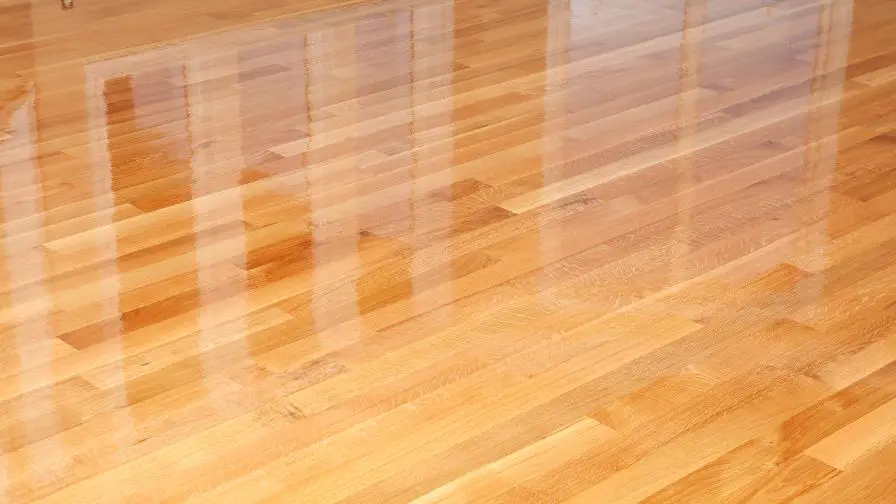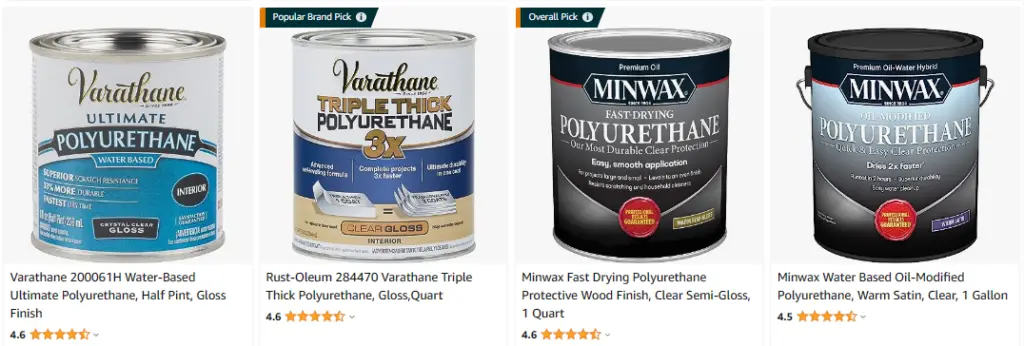
Finishing your woodworking project with a beautiful and smooth finish is the final step in ensuring your piece looks great. There are many types of finishes you can use, but water-based polyurethane is a popular choice because it is easy to apply and produces a nice finish.
In this blog post, we will show you how to get a smooth finish with water-based polyurethane.

Click Here To Check The Pricing On Amazon
Table of Contents
How Do You Apply Water-Based Polyurethane To Get A Smooth Finish On Your Project?
Applying water-based polyurethane is pretty simple. You just need to follow a few basic steps and you’ll be on your way to a smooth, professional-looking finish.
First, you’ll want to make sure that your project is clean and free of any dust or debris. You can do this by lightly sanding the surface with a fine-grit sandpaper. Once your project is clean, you can start applying the polyurethane.
To apply the polyurethane, you’ll need to use a foam brush or a natural bristle brush. Dip your brush into the polyurethane and then apply it to your project in long, even strokes. Be sure to brush in the direction of the grain to avoid creating any brush strokes.
Once you’ve applied a thin, even coat of polyurethane, you’ll need to let it dry for at least four hours. Once it’s dry, you can apply a second coat. Let your project dry completely before using or handling it. That’s all there is to it! Applying water-based polyurethane is a quick and easy way to achieve a smooth, professional-looking finish on your project.
Subscribe to Busted to Buffed Furniture Flipping on YouTube
What Is Water-Based Polyurethane And Why Is It A Popular Choice For Woodworking Projects?
Water-based polyurethane is a type of polymer made by reacting a polyol with isocyanate. Polyurethanes are versatile materials that can be used in many different applications, including coatings, adhesives, and sealants.
Water-based polyurethane is a popular choice for woodworking projects because it is easy to apply and dries quickly. It also provides a durable finish that is resistant to scratches and stains. Water-based polyurethane can be applied with a brush or roller, and it is available in both clear and pigmented formulas.
If you are considering using water-based polyurethane for your next woodworking project, be sure to read the manufacturer’s instructions carefully before you begin.
You will also need to take some basic safety precautions, such as wearing gloves and a respirator, to protect yourself from the fumes. Once you have applied the polyurethane, it is important to allow it to dry completely before using the item.
What Are The Benefits Of Using Water-Based Polyurethane Over Other Types Of Finishes?
Water-based polyurethane is a clear finish that is applied to wood to protect it from wear and tear. It is also used to give wood a beautiful shine.
Here are some benefits of using water-based polyurethane:
- Eco-friendly, healthier, and safer: Water-based polyurethane does not emit toxic fumes like oil-based polyurethane. It is also a renewable resource.
- Faster dry time: Water-based polyurethane dries quickly, so you can apply multiple coats in a shorter period.
- Durability: Water-based polyurethane is just as durable as oil-based polyurethane. It can withstand scratches, nicks, and scuffs.
- The clear finish maintains its original color: Water-based polyurethane will not yellow or darken over time like oil-based polyurethane. It will maintain the original color of the wood.
So, if you are looking for an eco-friendly, durable, and clear finish for your woodworking project, water-based polyurethane is a great option.
How Do You Keep Brush Marks From Water-Based Polyurethane?
If you’re using water-based polyurethane, you may find that it’s difficult to avoid brush marks.
Here are a few tips to help you get a smooth finish:
- Thin your polyurethane with paint thinner, mixing it with a paint stir stick. This will help the polyurethane flow more smoothly and reduce the risk of brush marks.
- Use a high-quality brush designed for use with water-based polyurethane. This will help to evenly distribute the finish and minimize brush marks.
- Apply several thin coats of polyurethane, rather than one thick coat. This will also help to smooth out the finish and reduce the appearance of brush marks.
With these tips, you should be able to get a smooth, brush-mark-free finish with your water-based polyurethane.
What Is The Best Brush For Water-Based Polyurethane?
The key to getting a smooth finish with any type of polyurethane is to use the right brush.
For water-based poly, we recommend the Wooster Angle Paintbrush.
This brush is designed specifically for use with water-based finishes, and it does a great job of applying an even coat of poly to your project.
If you’re using oil-based polyurethane, we would still recommend the Wooster Angle Paintbrush. It’s a great brush for oil-based finishes as well, and it will give you a smooth, even coat of poly every time.
So there you have it – the best brush for water-based polyurethane is the Wooster Angle Paintbrush. This brush works great with both oil and water-based polyurethane, and it will give you a smooth, even coat of poly every time. So if you’re looking for a smooth finish with your water-based polyurethane, make sure to use the Wooster Angle Paintbrush. You won’t be disappointed!
Subscribe to Crafted by Ray on YouTube
How Many Coats Of Water-Based Polyurethane Should I Use?
You are best off using three coats of water-based polyurethane for the best results.
The first coat should be thinned with paint thinner to help it penetrate the wood better and to reduce brush marks. Don’t worry if the first coat looks a little uneven; it will level out as it dries.
For the second and third coats, apply the finish to full strength. Let each coat dry thoroughly before applying the next one. And be sure to sand lightly between coats with fine-grit sandpaper to help improve the final smoothness of the surface.
Do You Have To Sand Between Water-Based Polyurethane Coats?
You should sand between coats to create the best possible finish. You can apply up to three coats of water-based polyurethane in a day. If you do sand between coats, be sure to use a very fine 220-grit sandpaper and wipe off any sanding dust with a damp cloth before applying the next coat.
Water-based polyurethane dries quickly, so you’ll need to work quickly and have all your tools and materials ready before you begin.




